THE SILK ROAD
In 2022 Midori Takaki (ceramic sculptor) and I agreed to collaborate on a project to make work inspired by the Silk Road.
The Silk Road originated in China more than a thousand years ago, beginning a network of trade routes which spread across continents from East to West. Massive wealth was generated by travellers trading in silks, spices, and precious gems along the routes. Not only were goods traded, but also religions, philosophies and ideas. Along the routes wars were fought and empires built. The history of the Silk Roads is an endlessly rich source of inspiration for artists and those working in the creative arts.
Silk Roads Exhibition Proposal.pdf
Artist's Statement
CV
SILK
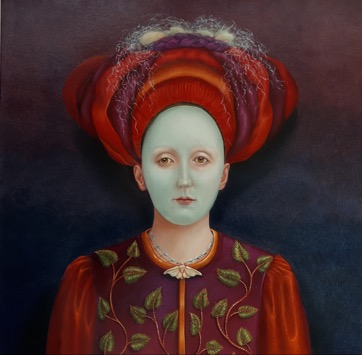
THE MUSE
oil on panel
38 x 30cm
The legend of the Silk Princess tells the story of how the secrets of silk farming came to Khotan, an ancient city in the Xinjiang Province on the Southern edge of the Taklaman Desert. On her marriage to the King of Khotan, the Princess brought silk worm eggs and mulberry seeds to Khotan hidden in her headdress as a gift to her new people.
In my painting, made before I was aware of the legend, sericulture is represented by the silk worm cocoons nestling within the silk turban, the embroidery of mulberry leaves on the waistcoat and the silk moth motif in the necklace.
Silk production was exclusive to China until the Silk Road began to emerge in 114 BC. The white mask of ‘The Muse’ references the Chinese cultural tradition of white face paint.
PRECIOUS GEMS
DIAMOND JACK 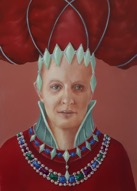
 LA PEREGRINA
LA PEREGRINA
both oil on gessobord
18 x 13cm
These two paintings represent the lucrative trade in diamonds, jade and precious gemstones found in Central Asia and other locations along the Silk Routes. Diamond Jack (Private Collection) proudly displays the resulting wealth in the jewellery that adorns his tunic.
La Peregrina was the name given to a pearl found off the coast of Panama in 1513. At the time it was the largest perfect pear-shaped pearl ever found anywhere in the world. It was given as a gift to King Phillip II of Spain in the 1530s and stayed in the Spanish Royal Collection for 200 years. My painting re-imagines a young Spanish princess wearing the famous pearl with a collar of jade and other precious gemstones.
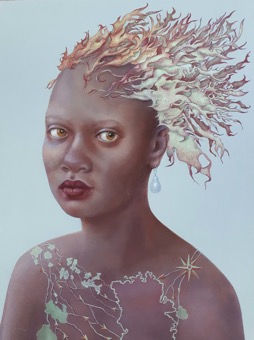
THE PARADOX AND THE PEARL
oil on panel
33 x 23cm
The famous Peregrina pearl was in fact discovered by an enslaved African diver in 1513. The diver was said to have been rewarded for his discovery with the gift of his freedom, but there is no evidence to support this claim. Despite the fact that it was gifted to the Spanish monarchy, and subsequently owned by various fabulously wealthy individuals, in my painting it is worn by an African girl. On her head she carries a type of seaweed found in the waters off the coast of Panama, and on her body is drawn a map of the Pearl Islands.
CULTURES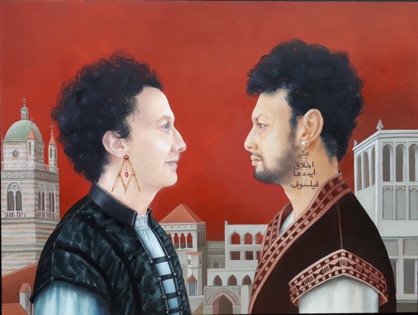
A SILK ROUTE ENCOUNTER
oil on panel
33 x 23cm
This painting depicts a meeting of minds and the exchange of ideas.
On the left I imagine an architect from Genoa, an important Silk Route port, on the right a philosopher from Bahrain. The buildings in the background combine the architecture found in both places. A closer examination of the painting reveals symbolic references to the occupations of the two men.
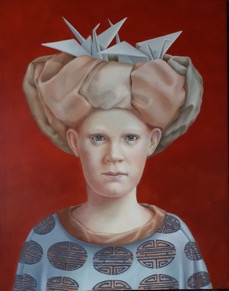
THE SIGNIFICANCE OF PAPER CRANES
oil on panel
38 x 30cm
A juxtaposition of symbols from Chinese and Japanese culture illustrate the exchange of ideas and beliefs between the two countries which began as early as 630BC, long before Japan officially became part of the Silk Route.
In the history of both countries the crane was used in the arts as a symbol of longevity. In my painting, Japanese origami paper cranes nest in the young boy’s hat while a Chinese symbol representing longevity (Shou) forms the patterns on his shirt.
TRADERS
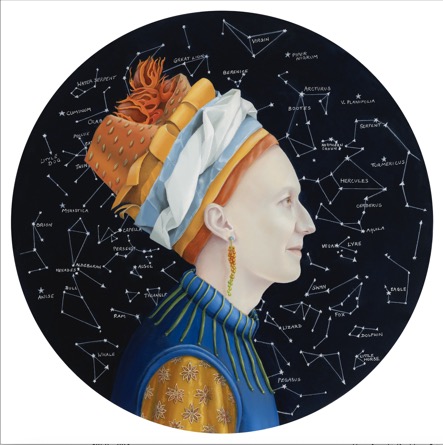
THE SPICE TRADER
oil on linen laid on board
46cm diameter
The first of a pair of two circular paintings depicting traders travelling along the Silk Roads. Nutmeg, Cumin, black pepper, vanilla and Star Anise all feature in the Spice Trader's costume and can also be found hidden in the Northern Hemisphere constellations that form the background to the painting.
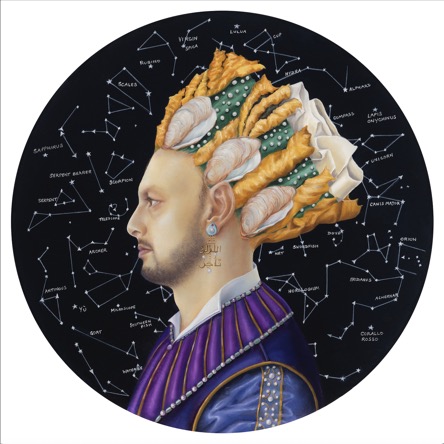
THE PEARL TRADER
oil on linen laid on board
46cm diameter
The second of a pair of two circular paintings depicting traders who travelled along the Silk Roads. Pearls, jade, turquoise, rubies and emeralds all feature in the Pearl Trader's costume and can also be found hidden in the Southern Hemisphere constellations that form the background to the painting.
THE DUTCH EAST INDIA COMPANY
(works in progress)
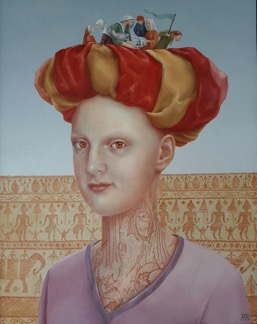
’s-HERTOGENBOSCH TO JAKARTA
oil on panel
38 x 30cm
In 1595 the first Dutch ships set sail to the East Indies to access spices directly from Asia, eventually waging war, colonising the Indonesian archipelago and enslaving its people. It’s a cruel history, but in contrast, my painting is a light-hearted fusion of cultures, incorporating the paintings of 15th century Dutch artist Hieronymus Bosch, the silks of India and the textile patterns of Indonesia.
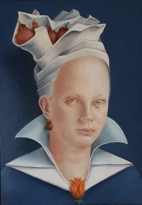
SOUVENIR
oil on gessobord
18 x 13cm
Tulips, originally found growing wild in Central Asia, were transported along the Silk Road to Turkey in the 14th century and cultivated as highly prized plants for the palace gardens of the Sultans. In the 16th century the bulbs were introduced into Europe via the Maritime Silk Routes and were traded amongst Europeans, particularly the Dutch, as an extremely valuable commodity. I imagine the subject of my painting to be a young sailor working on a Dutch ship who secretes a number of tulip bulbs in his headdress to take home as souvenirs.
To see the beautiful ceramic sculptures created by Midori Takaki on the Silk Road theme, please visit her website:
https://www.midoritakaki.co.uk/silk-road
